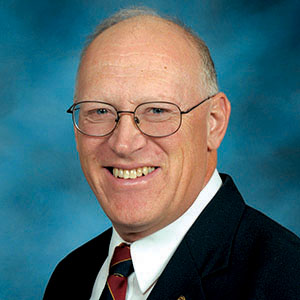Kansas Profile – Now That’s Rural: Eric Spurgeon, Tarhun 3D
At a glance: After graduating from K-State in mechanical engineering, Michael Spurgeon has designed and built projects across the country, from a display case to exhibit the Liberty Bell 7 spacecraft, to a sprayer designed for rice fields in California.
More information: Ron Wilson, rwilson@ksu.edu, 785-532-7690
Photos: Ron Wilson | Eric Spurgeon
Website: Huck Boyd National Institute for Rural Development
Sept. 25, 2024

By Ron Wilson, director of the Huck Boyd National Institute for Rural Development at Kansas State University
Today let’s go visit one of the first spacecraft in which American astronauts flew into outer space: the Liberty Bell 7, the second U.S. manned space capsule in history.
This spaceship is being exhibited in a special display case custom-designed by an engineer in rural Kansas, Eric Spurgeon, who we introduced in last week’s column.
Spurgeon grew up in southwest Kansas and always had an interest in how things work. From an early age, he knew he wanted to be an engineer.
![]()
Spurgeon earned his degree in mechanical engineering from Kansas State University and worked as an engineer in northeast Kansas for three years. Then Spurgeon and his wife moved to Buhler where today he operates the Iron Hedge company.
At right: Eric Spurgeon | Download this photo
In September 2017, Spurgeon launched his own engineering consulting company called Tarhun 3D.
“Tarhun is an ancient Assyrian word meaning ‘to conquer,’” Spurgeon said, adding that 3D refers to the company’s motto: Design, Develop, Deliver, plus the fact that they use advanced 3D CAD software
“Our goal is to conquer hard engineering challenges in the mechanical space,” Spurgeon said.
One challenging project was to design the display case for the Liberty Bell 7 space capsule.
The Liberty Bell 7 was launched on July 21, 1961, carrying astronaut Gus Grissom. The flight was successful, but disaster almost occurred after the landing. Ironically, it was not outer space that was almost fatal, it was the ocean and the near-drowning that followed.
The Liberty Bell 7 successfully splashed down in the Atlantic Ocean. A Marine helicopter was there to pick it up. Suddenly the space capsule’s hatch blew open prematurely and it started to fill with water.
Astronaut Grissom managed to get out of the capsule before it sank, but his spacesuit was taking in water through the oxygen vent. He nearly drowned before the Marine helicopter could pluck him from the water. The space capsule was lost on the ocean floor under 15,000 feet of water.
According to the National Air and Space Museum’s website, this was “the second U.S. human spaceflight, and the first one that was nearly fatal.”
Liberty Bell 7 remained on the ocean floor for nearly four decades. In 1999, a deep sea salvage mission was able to locate and retrieve it.
In order to facilitate its recovery and conservation, NASA voluntarily gave the spacecraft’s title to the Cosmosphere Museum in Hutchinson, Kansas where the spacecraft resides today. It is the only Mercury, Gemini, or Apollo spacecraft flown by astronauts that the Smithsonian’s National Air and Space Museum does not own.
Liberty Bell 7 can be viewed in a special sealed display case that has temperature and humidity controls -- designed by Spurgeon.
“It was an honor to help preserve such a unique piece of space history,” notes the Tarhun 3D website.
This is only one example of the type of creative projects taken on by Tarhun 3D. In another case, Tarhun 3D helped develop a groundbreaking device that implements a type of radio frequency thermal treatment that is expected to increase the efficacy of current cancer treatments.
The company offers its engineering services on a project basis. Many projects involve transportation or industrial processing equipment. Agricultural projects include a custom fertilizer application toolbar and a spray boom specifically designed for the rice fields of California. Other projects range from filtration equipment to explosion suppression and containment.
“I love problem-solving,” Spurgeon said. “We get referred to the hard stuff that other people don’t want to tackle.”
Tarhun 3D has more than 40 clients in 12 industries across the U.S. It’s an impressive business to find in a rural community such as Buhler, population 1,325 people. Now, that’s rural.
For more information, go to www.tarhun3d.com.
It’s time to leave the Cosmosphere Museum where the historic Liberty Bell 7 spacecraft can be viewed in a special display case designed by a rural Kansas engineer. We commend Eric Spurgeon of Tarhun 3D for making a difference with his mechanical design expertise, helping companies solve engineering problems that are out of this world.
Audio and text files of Kansas Profiles are available at www.huckboydinstitute.org/kansas-profiles. For more information about the Huck Boyd Institute, interested persons can visit www.huckboydinstitute.org.
***

K‑State Research and Extension is a short name for the Kansas State University Agricultural Experiment Station and Cooperative Extension Service, a program designed to generate and distribute useful knowledge for the well‑being of Kansans. Supported by county, state, federal and private funds, the program has county extension offices, experiment fields, area extension offices and regional research centers statewide. Its headquarters is on the K‑State campus in Manhattan. For more information, visit www.ksre.ksu.edu. K-State Research and Extension is an equal opportunity provider and employer.